window Seat Leon 5D 2010 MEDIA SYSTEM 2.2
[x] Cancel search | Manufacturer: SEAT, Model Year: 2010, Model line: Leon 5D, Model: Seat Leon 5D 2010Pages: 99, PDF Size: 3.66 MB
Page 10 of 99
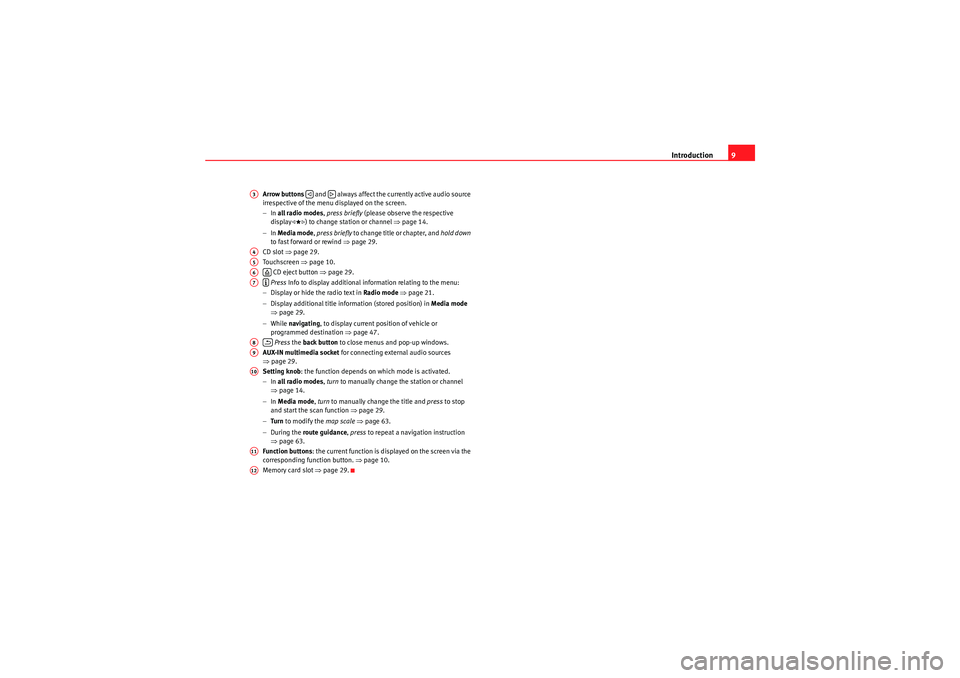
Introduction9
Arrow buttons and always affect the currently active audio source
irrespective of the menu displayed on the screen.
− In all radio modes , press briefly (please observe the respective
display
�
) to change station or channel ⇒page 14.
− In Media mode , press briefly to change title or chapter, and hold down
to fast forward or rewind ⇒page 29.
CD slot ⇒page 29.
Touch scre en ⇒page 10.
CD eject button ⇒page 29.
Press Info to display additional information relating to the menu:
− Display or hide the radio text in Radio mode ⇒ page 21.
− Display additional title information (stored position) in Media mode
⇒ page 29.
− While navigating , to display current position of vehicle or
programmed destination ⇒page 47.
Press the back button to close menus and pop-up windows.
AUX-IN multimedia socket for connecting external audio sources
⇒ page 29.
Setting knob : the function depends on which mode is activated.
− In all radio modes , turn to manually change the station or channel
⇒ page 14.
− In Media mode , turn to manually change the title and press to stop
and start the scan function ⇒page 29.
− Tu r n to modify the map scale ⇒ page 63.
− During the route guidance , press to repeat a navigation instruction
⇒ page 63.
Function buttons : the current function is displayed on the screen via the
corresponding function button. ⇒page 10.
Memory card slot ⇒page 29.
A3
�ƒ
�„
A4A5A6
�š
A7
�º
A8
�E
A9A10A11A12
MediaSystem2.1_EN.book Seite 9 Donnerstag, 29. April 2010 4:18 16
Page 13 of 99
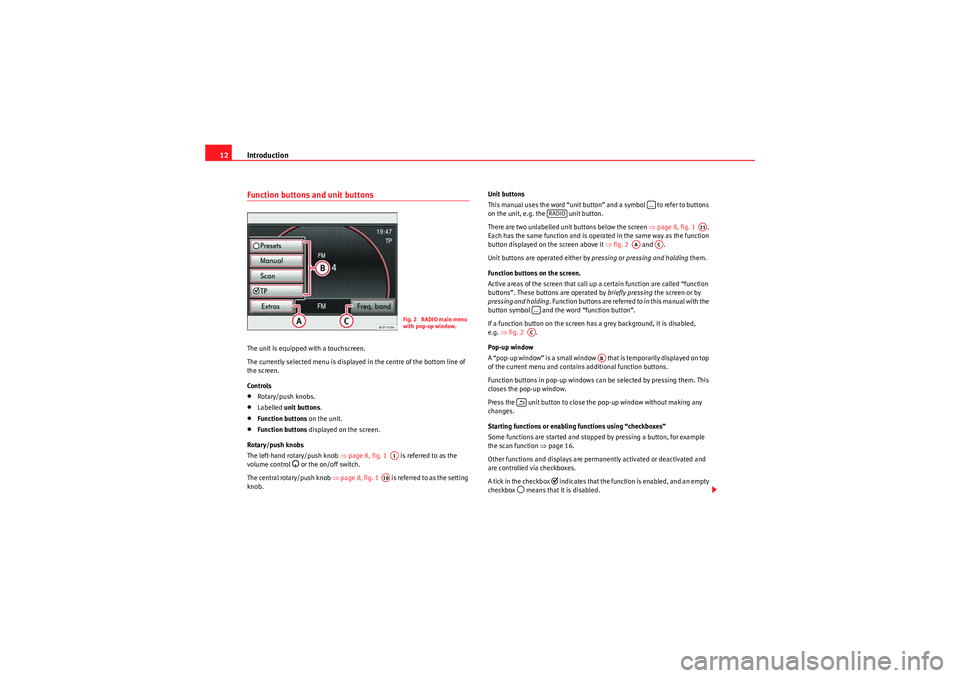
Introduction
12Function buttons and unit buttonsThe unit is equipped with a touchscreen.
The currently selected menu is displayed in the centre of the bottom line of
the screen.
Controls•Rotary/push knobs.•Labelled unit buttons .•Function buttons on the unit.•Function buttons displayed on the screen.
Rotary/push knobs
The left-hand rotary/push knob ⇒page 8, fig. 1 is referred to as the
volume control
�D or the on/off switch.
The central rotary/push knob ⇒page 8, fig. 1 is referred to as the setting
knob. Unit buttons
This manual uses the word “unit button” and a symbol to refer to buttons
on the unit, e.g. the unit button.
There are two unlabelled unit buttons below the screen
⇒page 8, fig. 1 .
Each has the same function and is operated in the same way as the function
button displayed on the screen above it ⇒fig. 2 and .
Unit buttons are operated either by pressing or pressing and holding them.
Function buttons on the screen.
Active areas of the screen that call up a certain function are called “function
buttons”. These buttons are operated by briefly pressing the screen or by
pressing and holding . Function buttons are referred to in this manual with the
button symbol and the word “function button”.
If a function button on the screen has a grey background, it is disabled,
e.g. ⇒fig. 2 .
Pop-up window
A “pop-up window” is a small window that is temporarily displayed on top
of the current menu and contains additional function buttons.
Function buttons in pop-up windows can be selected by pressing them. This
closes the pop-up window.
Press the unit button to close the pop-up window without making any
changes.
Starting functions or enabling functions using “checkboxes”
Some functions are started and stopped by pressing a button, for example
the scan function ⇒ page 16.
Other functions and displays are permanently activated or deactivated and
are controlled via checkboxes.
A tick in the checkbox
�’ indicates that the function is enabled, and an empty
checkbox
�‰ means that it is disabled.
Fig. 2 RADIO main menu
with pop-up window.
A1
A10
...
RADIO
A11
AA
AC
...AC
AB
�E
MediaSystem2.1_EN.book Seite 12 Donnerstag, 29. April 2010 4:18 16
Page 14 of 99
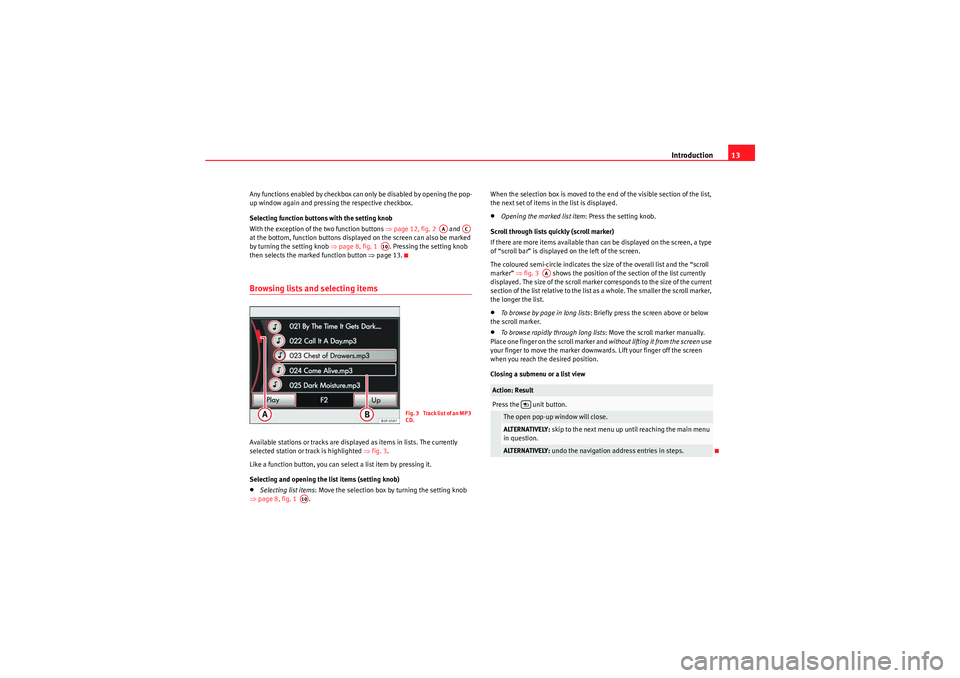
Introduction13
Any functions enabled by checkbox can only be disabled by opening the pop-
up window again and pressing the respective checkbox.
Selecting function buttons with the setting knob
With the exception of the two function buttons ⇒page 12, fig. 2 and
at the bottom, function buttons displayed on the screen can also be marked
by turning the setting knob ⇒page 8, fig. 1 . Pressing the setting knob
then selects the marked function button ⇒page 13.Browsing lists and selecting itemsAvailable stations or tracks are displayed as items in lists. The currently
selected station or track is highlighted ⇒fig. 3 .
Like a function button, you can select a list item by pressing it.
Selecting and opening the list items (setting knob)•Selecting list items : Move the selection box by turning the setting knob
⇒ page 8, fig. 1 . When the selection box is moved to the end of the visible section of the list,
the next set of items in the list is displayed.
•Opening the marked list item
: Press the setting knob.
Scroll through lists quickly (scroll marker)
If there are more items available than can be displayed on the screen, a type
of “scroll bar” is displayed on the left of the screen.
The coloured semi-circle indicates the size of the overall list and the “scroll
marker” ⇒fig. 3 shows the position of the section of the list currently
displayed. The size of the scroll marker corresponds to the size of the current
section of the list relative to the list as a whole. The smaller the scroll marker,
the longer the list.•To browse by page in long lists : Briefly press the screen above or below
the scroll marker.•To browse rapidly through long lists : Move the scroll marker manually.
Place one finger on the scroll marker and without lifting it from the screen use
your finger to move the marker downwards. Lift your finger off the screen
when you reach the desired position.
Closing a submenu or a list view
AA
AC
A10
Fig. 3 Track list of an MP3
CD.
A10
Action: ResultPress the unit button.The open pop-up window will close.ALTERNATIVELY: skip to the next menu up until reaching the main menu
in question.ALTERNATIVELY: undo the navigation address entries in steps.
AA
MediaSystem2.1_EN.book Seite 13 Donnerstag, 29. April 2010 4:18 16
Page 15 of 99
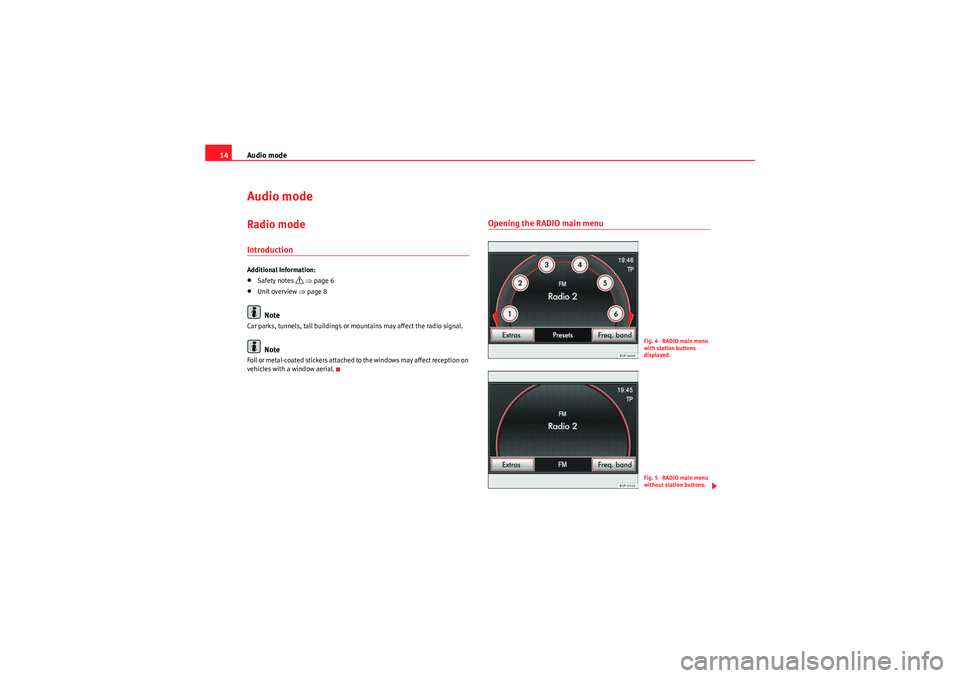
Audio mode
14Audio modeRadio modeIntroductionAdditional Information:•Safety notes
�’ ⇒ page 6
•Unit overview ⇒page 8Note
Car parks, tunnels, tall buildings or mountains may affect the radio signal.
Note
Foil or metal-coated stickers attached to the windows may affect reception on
vehicles with a window aerial.
Opening the RADIO main menu
Fig. 4 RADIO main menu
with station buttons
displayed.Fig. 5 RADIO main menu
without station buttons.
MediaSystem2.1_EN.book Seite 14 Donnerstag, 29. April 2010 4:18 16
Page 17 of 99
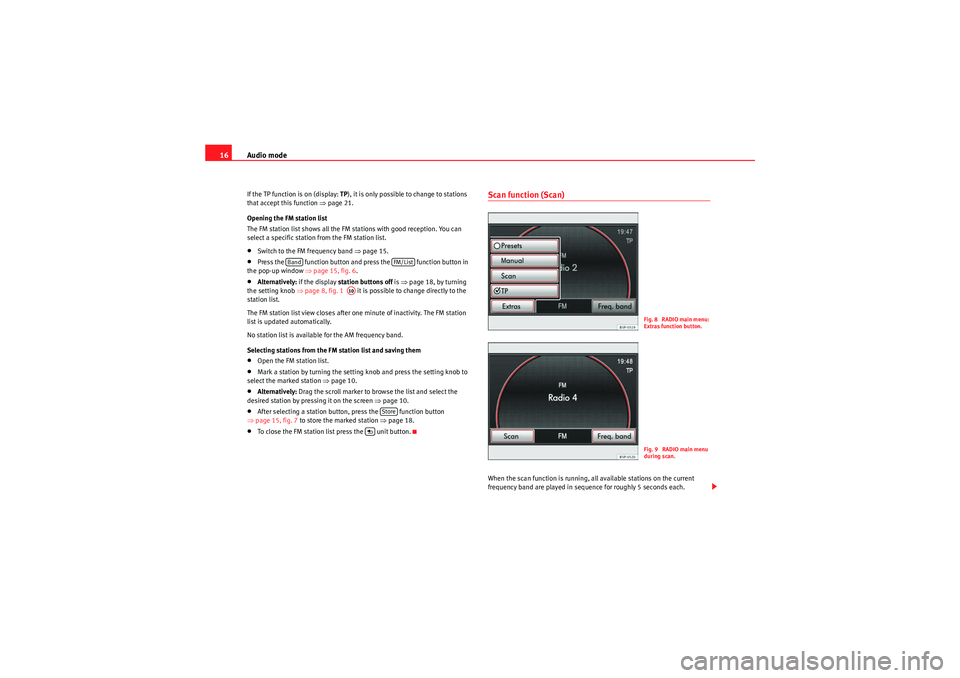
Audio mode
16If the TP function is on (display: TP), it is only possible to change to stations
that accept this function ⇒page 21.
Opening the FM station list
The FM station list shows all the FM stations with good reception. You can
select a specific station from the FM station list.•Switch to the FM frequency band ⇒page 15.•Press the function button and press the function button in
the pop-up window ⇒page 15, fig. 6 .•Alternatively:if the display station buttons off is ⇒ page 18, by turning
the setting knob ⇒page 8, fig. 1 it is possible to change directly to the
station list.
The FM station list view closes after one minute of inactivity. The FM station
list is updated automatically.
No station list is available for the AM frequency band.
Selecting stations from the FM station list and saving them•Open the FM station list.•Mark a station by turning the setting knob and press the setting knob to
select the marked station ⇒page 10.•Alternatively: Drag the scroll marker to browse the list and select the
desired station by pressing it on the screen ⇒page 10.•After selecting a station button, press the function button
⇒ page 15, fig. 7 to store the marked station ⇒ page 18.•To close the FM station list press the unit button.
Scan function (Scan)When the scan function is running, all available stations on the current
frequency band are played in sequence for roughly 5 seconds each.
Band
FM/List
A10
Store
Fig. 8 RADIO main menu:
Extras function button.Fig. 9 RADIO main menu
during scan.
MediaSystem2.1_EN.book Seite 16 Donnerstag, 29. April 2010 4:18 16
Page 18 of 99
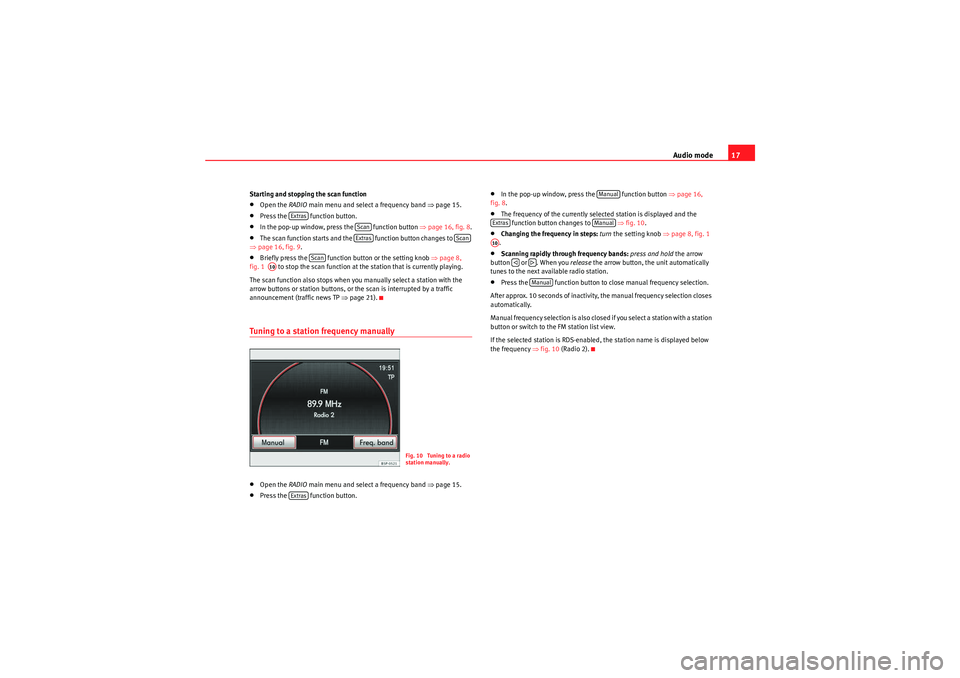
Audio mode17
Starting and stopping the scan function•Open the RADIO main menu and select a frequency band ⇒ page 15.•Press the function button.•In the pop-up window, press the function button ⇒page 16, fig. 8 .•The scan function starts and the function button changes to
⇒ page 16, fig. 9.•Briefly press the function button or the setting knob ⇒page 8,
fig. 1 to stop the scan function at the station that is currently playing.
The scan function also stops when you manually select a station with the
arrow buttons or station buttons, or the scan is interrupted by a traffic
announcement (traffic news TP ⇒page 21).Tuning to a station frequency manually•Open the RADIO main menu and select a frequency band ⇒ page 15.•Press the function button.
•In the pop-up window, press the function button ⇒ page 16,
fig. 8 .•The frequency of the currently selected station is displayed and the
function button changes to ⇒fig. 10 .•Changing the frequency in steps: turn the setting knob ⇒page 8, fig. 1
.•Scanning rapidly through frequency bands: press and hold the arrow
button or . When you release the arrow button, the unit automatically
tunes to the next available radio station.•Press the function button to close manual frequency selection.
After approx. 10 seconds of inactivity, the manual frequency selection closes
automatically.
Manual frequency selection is also closed if you select a station with a station
button or switch to the FM station list view.
If the selected station is RDS-enabled, the station name is displayed below
the frequency ⇒ fig. 10(Radio 2).
Extras
ScanExtras
Scan
Scan
A10
Fig. 10 Tuning to a radio
station manually.
Extras
Manual
Extras
Manual
A10
�ƒ
�„Manual
MediaSystem2.1_EN.book Seite 17 Donnerstag, 29. April 2010 4:18 16
Page 24 of 99
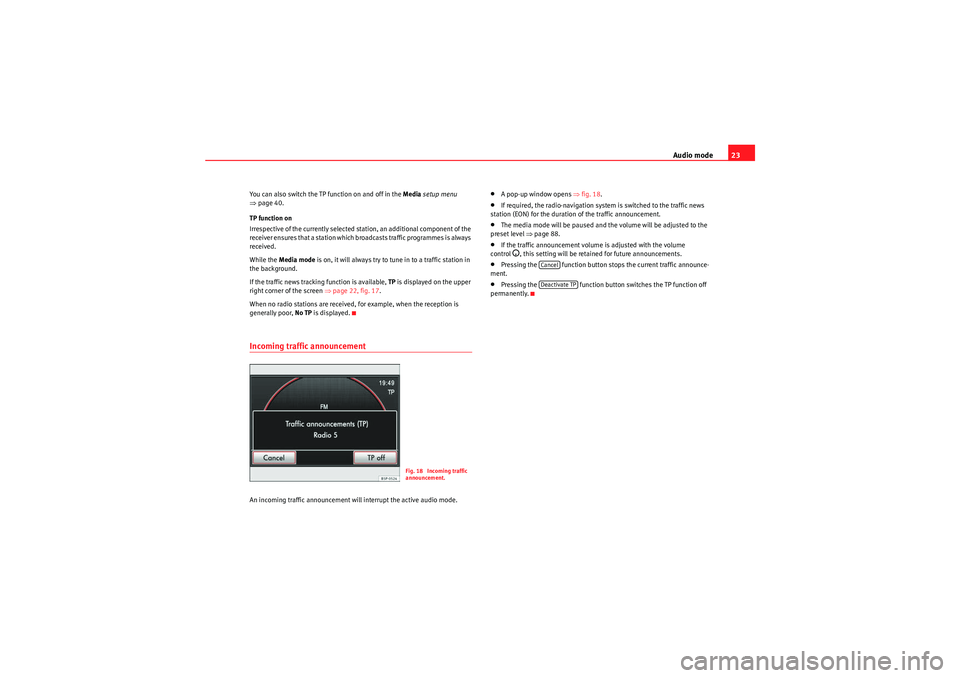
Audio mode23
You can also switch the TP function on and off in the Media setup menu
⇒ page 40.
TP function on
Irrespective of the currently selected station, an additional component of the
receiver ensures that a station which broadcasts traffic programmes is always
received.
While the Media mode is on, it will always try to tune in to a traffic station in
the background.
If the traffic news tracking function is available, TP is displayed on the upper
right corner of the screen ⇒page 22, fig. 17 .
When no radio stations are received, for example, when the reception is
generally poor, No TP is displayed.Incoming traffic announcement An incoming traffic announcement will interrupt the active audio mode.
•A pop-up window opens ⇒fig. 18.•If required, the radio-navigation system is switched to the traffic news
station (EON) for the duration of the traffic announcement.•The media mode will be paused and the volume will be adjusted to the
preset level ⇒page 88.•If the traffic announcement volume is adjusted with the volume
control
�D, this setting will be retained for future announcements.
•Pressing the function button stops the current traffic announce-
ment.•Pressing the function button switches the TP function off
permanently.
Fig. 18 Incoming traffic
announcement.
CancelDeactivate TP
MediaSystem2.1_EN.book Seite 23 Donnerstag, 29. April 2010 4:18 16
Page 26 of 99
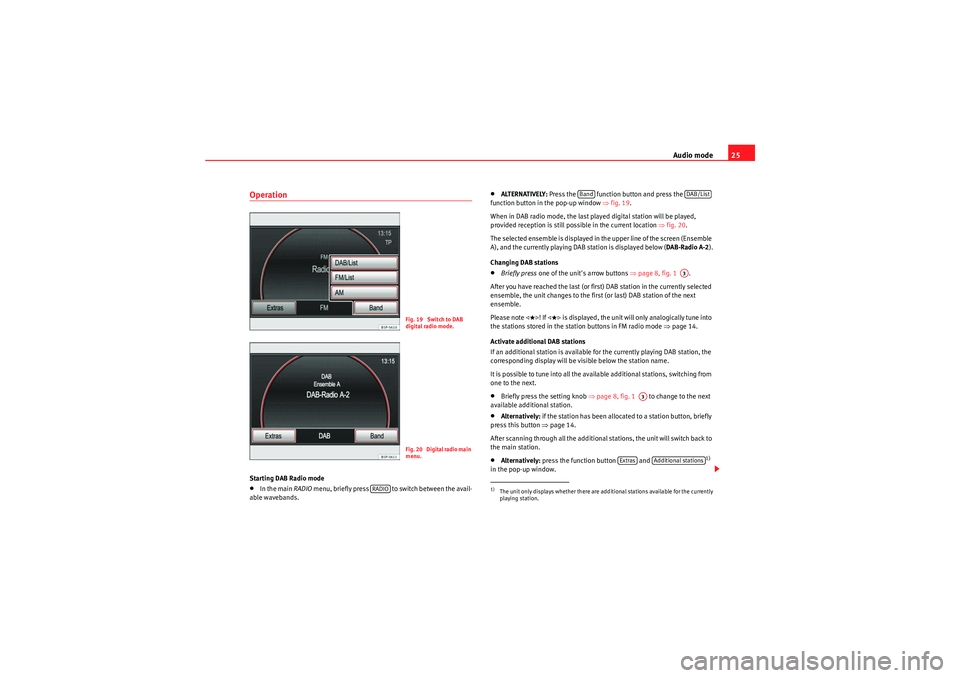
Audio mode25
OperationStarting DAB Radio mode•In the main RADIO menu, briefly press to switch between the avail-
able wavebands.
•ALTERNATIVELY: Press the function button and press the
function button in the pop-up window ⇒fig. 19 .
When in DAB radio mode, the last played digital station will be played,
provided reception is still possible in the current location ⇒fig. 20.
The selected ensemble is displayed in the upper line of the screen (Ensemble
A), and the currently playing DAB station is displayed below ( DAB-Radio A-2).
Changing DAB stations•Briefly press one of the unit's arrow buttons ⇒ page 8, fig. 1 .
After you have reached the last (or first) DAB station in the currently selected
ensemble, the unit changes to the first (or last) DAB station of the next
ensemble.
Please note
�
! If �
is displayed, the unit will only analogically tune into
the stations stored in the station buttons in FM radio mode ⇒page 14.
Activate additional DAB stations
If an additional station is available for the currently playing DAB station, the
corresponding display will be visible below the station name.
It is possible to tune into all the available additional stations, switching from
one to the next.
•Briefly press the setting knob ⇒ page 8, fig. 1 to change to the next
available additional station.•Alternatively: if the station has been allocated to a station button, briefly
press this button ⇒page 14.
After scanning through all the additional stations, the unit will switch back to
the main station.•Alternatively: press the function button and
1)
in the pop-up window.
Fig. 19 Switch to DAB
digital radio mode.Fig. 20 Digital radio main
menu.
RADIO
1)The unit only displays whether there are additional stations available for the currently
playing station.
Band
DAB/ListA3
A3
Extras
Additional stations
MediaSystem2.1_EN.book Seite 25 Donnerstag, 29. April 2010 4:18 16
Page 27 of 99
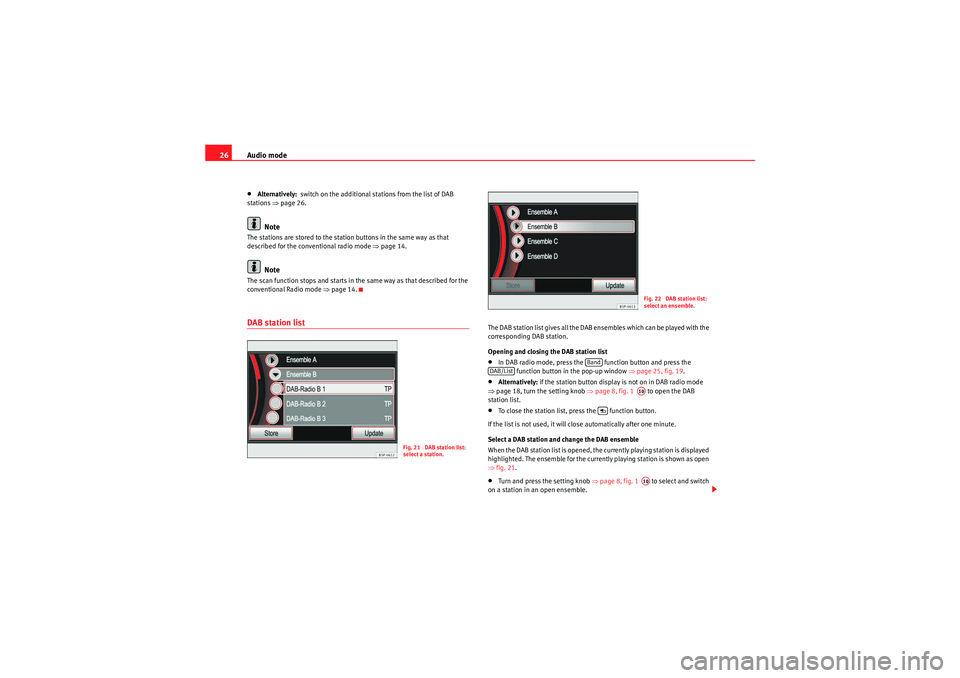
Audio mode
26•Alternatively: switch on the additional stations from the list of DAB
stations ⇒page 26.Note
The stations are stored to the station buttons in the same way as that
described for the conventional radio mode ⇒page 14.
Note
The scan function stops and starts in the same way as that described for the
conventional Radio mode ⇒page 14.DAB station list
The DAB station list gives all the DAB ensembles which can be played with the
corresponding DAB station.
Opening and closing the DAB station list•In DAB radio mode, press the function button and press the
function button in the pop-up window ⇒page 25, fig. 19 .•Alternatively:if the station button display is not on in DAB radio mode
⇒ page 18, turn the setting knob ⇒page 8, fig. 1 to open the DAB
station list.•To close the station list, press the function button.
If the list is not used, it will close automatically after one minute.
Select a DAB station and change the DAB ensemble
When the DAB station list is opened, the currently playing station is displayed
highlighted. The ensemble for the currently playing station is shown as open
⇒ fig. 21.•Turn and press the setting knob ⇒page 8, fig. 1 to select and switch
on a station in an open ensemble.
Fig. 21 DAB station list:
select a station.
Fig. 22 DAB station list:
select an ensemble.
Band
DAB/List
A10
A10
MediaSystem2.1_EN.book Seite 26 Donnerstag, 29. April 2010 4:18 16
Page 28 of 99
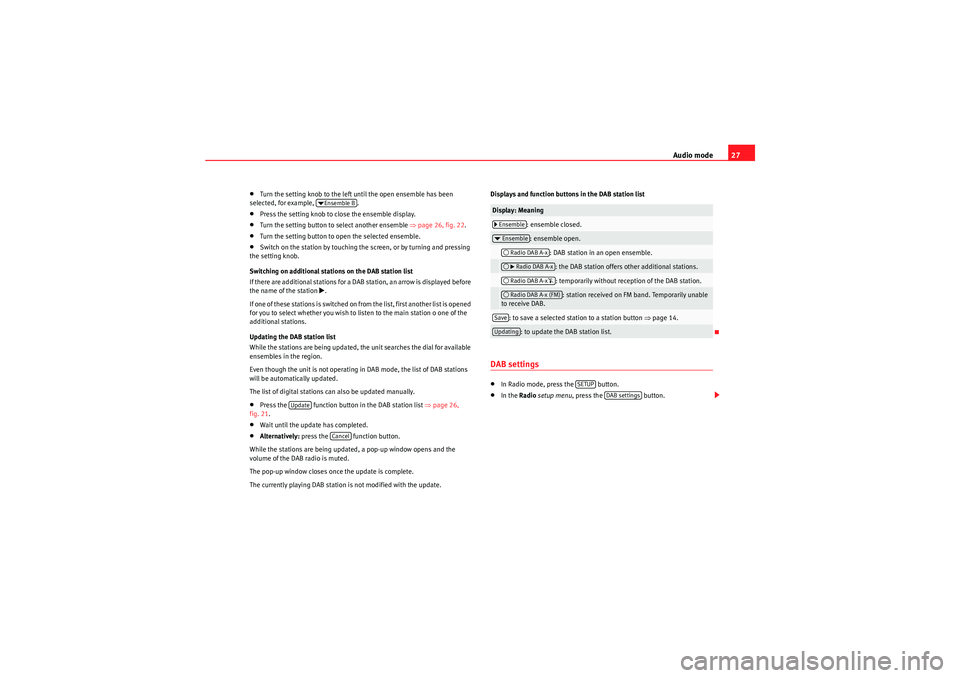
Audio mode27
•Turn the setting knob to the left until the open ensemble has been
selected, for example, .•Press the setting knob to close the ensemble display.•Turn the setting button to select another ensemble ⇒page 26, fig. 22.•Turn the setting button to open the selected ensemble.•Switch on the station by touching the screen, or by turning and pressing
the setting knob.
Switching on additional stations on the DAB station list
If there are additional stations for a DAB station, an arrow is displayed before
the name of the station
�b.
If one of these stations is switched on from the list, first another list is opened
for you to select whether you wish to listen to the main station o one of the
additional stations.
Updating the DAB station list
While the stations are being updated, the unit searches the dial for available
ensembles in the region.
Even though the unit is not operating in DAB mode, the list of DAB stations
will be automatically updated.
The list of digital stations can also be updated manually.
•Press the function button in the DAB station list ⇒page 26,
fig. 21 .•Wait until the update has completed.•Alternatively: press the function button.
While the stations are being updated, a pop-up window opens and the
volume of the DAB radio is muted.
The pop-up window closes once the update is complete.
The currently playing DAB station is not modified with the update. Displays and function buttons in the DAB station list
DAB settings•In Radio mode, press the button.•In the
Radio setup menu , press the button.
�tEnsemble B
Update
Cancel
Display: Meaning
: ensemble closed.: ensemble open.
: DAB station in an open ensemble.: the DAB station offers other additional stations.: temporarily without reception of the DAB station.: station received on FM band. Temporarily unable
to receive DAB.
: to save a selected station to a station button ⇒page 14.
: to update the DAB station list.
�…Ensemble�t Ensemble�‰Radio DAB A-x�‰�b Radio DAB A-x�‰Radio DAB A-x �µ�‰Radio DAB A-x (FM)SaveUpdating
SETUP
DAB settings
MediaSystem2.1_EN.book Seite 27 Donnerstag, 29. April 2010 4:18 16